What the ... ?
I meant to share this picture of a growth on a water oak for some weeks now. I took the picture a few weeks into the lockdown. I took lots of walks in the woods with my wife’s dog, and found this marble-sized hard growth on an oak branch. This week’s “What the … ?” is not a difficult one. Answer is at the end of this newsletter.
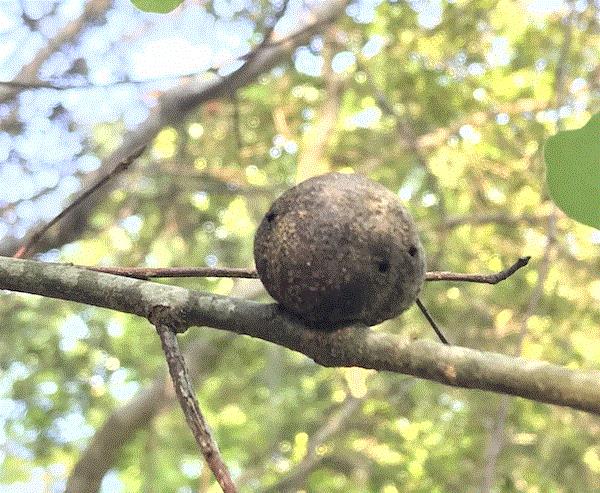
Broad mite management
I received several requests for identification or management recommendations for broad mite in the last couple of weeks. Most samples were infested with broad mites. The distortions on other samples, on the other hand, are perhaps due to poor plant genetics. I’ve seen and received an increasing number of calls for help with broad mite in the past few years, first from mainly vegetable growers but now increasingly from outdoor ornamental growers.
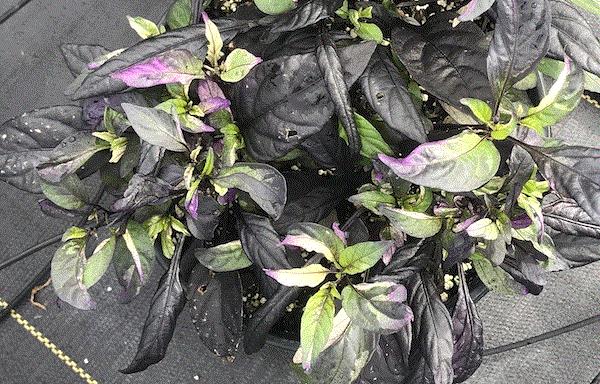
Terminals damaged by broad mite appear twisted and crinkled.
Broad mite loves to infest new growth. Tissues damaged by broad mites don't expand properly, so the leaves and flowers are distorted, twisted and crinkled. This symptom can often be confused with herbicide damage or poor genetics.
But, if it is broad mite, you’ll be able to find the mites or signs of them being there. The mites and their eggs are translucent, but you can still see them with a hand lens at 16 or 20 times magnification. I ain’t crazy enough to expect y’all to see the long hair sticking out from each mite’s hind legs; I can only see the hairs under a microscope. But, I think you can definitely see the eggs, which have several raised white tufts on the surface (look like spots to me), under a hand lens. Its elliptical shape and the white spots give the eggs the look of a football. The eggs stay on the plant surface even if the mites are gone. If you see the eggs, you can almost certainly diagnose this distortion as one caused by broad mite. Click here for a fun article by Nicole Casuso and Hugh Smith of University of Florida, with lots of pictures of broad mite life stages.
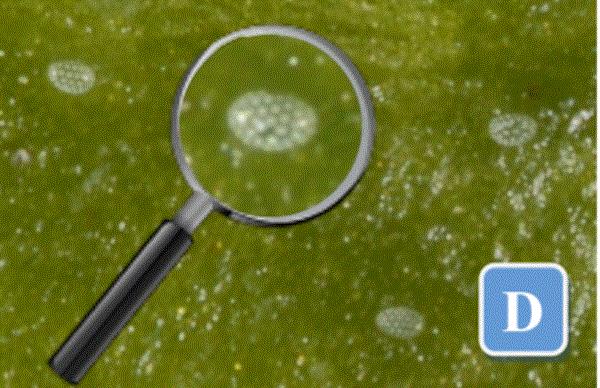
Eggs of broad mite look like footballs. (Photo from Nicole Casuso and Hugh Smith, 2017, University of Florida.)
Broad mites can complete one generation in a couple of weeks, and each female can lay 30 to 70 eggs. They have really interesting behaviors, especially when dispersing to new plants. Many of you probably heard of broad mites latching to the legs of adult whiteflies, and then dispersing to new plants when the whiteflies land. (Link to this article for a great picture!) This behavior, called phoresis, is interesting but, in my mind, no way near as interesting as what a male broad mite would do to ensure his reproductive success. Similar to spider mites, a broad mite goes through a quiescent stage before molting into an adult. A male broad mite will pick up one of these quiescent females, put the female on its back, and carry her everywhere he goes. Why? So that he can make sure that as soon as the female comes of age (i.e. molts into an adult), he can mate with her. Now, don't be anthropocentric and go “eww.” For a tiny broad mite in a land of giant plants, a male has to do what he can to pass on his genes.
Several predatory mite species, such as Amblyseius andersoni, Amblyseius swirskii, Neoseiulus californicus, Neoseiulus cucumeris and Neoseiulus fallacis, are available for biological control of broad mite. Several studies reported good efficacy with these predatory mites. The keys to success are to release the predatory mites preventively or as soon as damage is observed, and keep up with the program with regular releases.
Several miticides are registered for controlling tarsonemid mites (which include broad mite and its close cousin, cyclamen mite)—several pyrethoids (IRAC Group 3A), abamectin (Avid, Minx, Sirocco, etc.; 6), chlorfenapyr (Pylon; 13), fenpyroximate (Akari; 21A), pyridaben (Sanmite; 21A), spiromesifen (Savate/Forbid; 23) and spirotetramat (Kontos; 23). I worked with broad mite on and off in the past few years, and found two applications of Akari, Avid, Pylon and Savate, 14 days apart, to work quite well. In addition to the above products, data from IR-4 also suggest good efficacy from horticultural oil, insecticidal soap, emamectin benzoate (Enfold; 6), etoxazole (Beethoven; 10B), fenazaquin (Magus; 21A), hexythiazox (Hexygon; 10A), and milbemectin (Ultiflora; 6). Note that not all of these products are registered for broad mite or cyclamen mite, and some of them are no longer available (such as Ultiflora). Since the mites are hiding in the distorted terminals or crinkled leaves, adding a surfactant to the spray solution, and applying thoroughly and at a high volume can help improve efficacy. Also, here I go again: rotate, rotate, rotate.

Nemagard is introduced in the USA
A new biological control option for white grubs is now available. This new option is an entomopathogenic nematode, Steinernema scarabaei, to be available as Nemagard in the USA. This product has been available in Canada through Lawn Life Natural Turf Products for some times. It's now available to turfgrass growers and managers in the USA from Henry James Innovations and Pure Organic Products (information to be available on their websites soon).

There is no specific site restriction on the product label, so this product should be available to turf and ornamentals, and fruits and nuts where white grubs can be a problem. The application rate is 225 million nematodes (one package) for every 10,000 to 12,000 sq. ft. The product can be dissolved in water and sprayed to the target area with conventional spray equipment. Do remember to take out filters or screens in the nozzle.
Albrecht Koppenhöfer of Rutgers University tested this nematode species in his laboratory for the past few years and is gracious enough to share some of his study results. Field trial results suggested that this nematode species was effective against grubs of Japanese beetle, Oriental beetle, Asian garden beetle and European chafer, but less effective against grubs of May or June beetles (Phyllophaga species) and masked chafers (Cyclocephala species). A single application could wipe out the grub population in 30 days, maintain a high level of control (> 80% reduction in grub population from before treatment) in the first year, and result in a low grub population in the next several years. The efficacy of this nematode is the highest when applied against the second and third-instar grubs, so timing of applications would vary depending on the white grub life cycle at different locations. The nematode also does better in cooler and moist soil, so Albrecht recommends maintaining soil moisture at about 50% field capacity for at least one week after application. Based on study results, I think the application should be made before soil temperature exceeds 80 F.
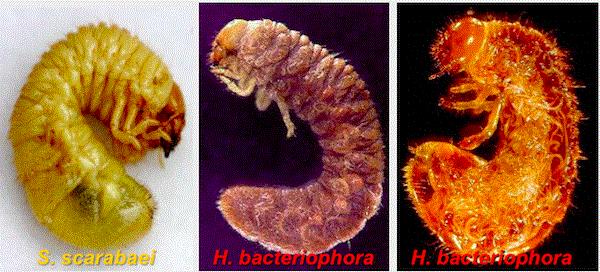
Different nematode species cause different colors in white grub cadavers. (Photo courtesy of Albrecht Koppenhofer, Rutgers University)

BT NOW is available in California
Last week, BioSafe Systems announced the approval of BT NOW by the California Department of Pesticide Regulation. BT NOW contains the entomopathogenic bacterium Bacillus thuringiensis subspecies kurstaki (Btk) strain EVB-113-19, which is the same strain in BioProtec Plus and Leprotec. Other Btk products contain different strains, such as ABTS-351 (DiPel and Biobit), EG7841 (Crymax) and SA-12 (Thuricide).

Btk is a bacterium that specializes in caterpillars—rotting their guts and killing them. (For details on how Bt products work, click here for a previous issue of this newsletter.) BT NOW is registered for the management of several species of caterpillars such as these southern armyworms I found wiping out a crop of asters in a nursery in Georgia two weeks ago. Other notable target pests include loopers, leafrollers and bagworms. The product can be used on various fruits, nuts, vegetables, herbs, and field crops, as well as ornamental plants grown in greenhouses, nurseries and landscapes. The REI of BT NOW is four hours. The product is OMRI-listed.
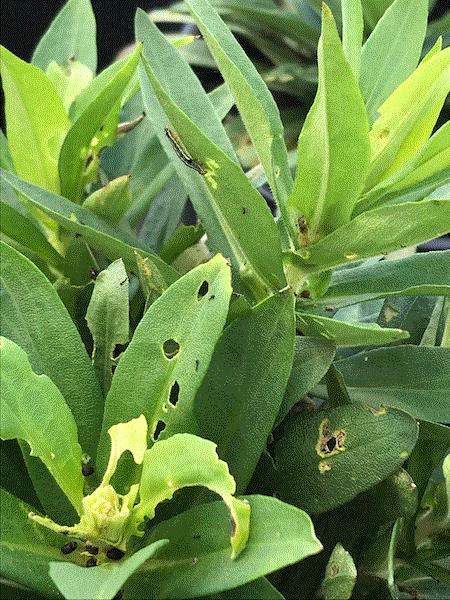

Answer to "What the ... ?"
What’s that growth on the water oak branch? If you guessed a “gall,” then you are correct. But, if you guessed “oak marble gall,” then you are spot on!
You can think of galls as tumors or a reaction by plants to infection by insects, mites, fungi, bacteria, etc. Most of them are of spectacular or bizarre shapes and sizes, such as these erineum galls I talked about a couple of years ago (click here for that issue).
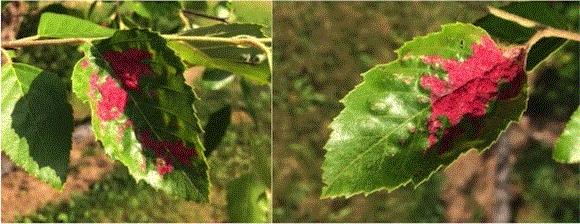
Oak marble gall is but one of many gall “species” on oaks. I’ve seen oak apple gall and “flower” galls in my own woods. Gouty oak gall and horned oak gall are pests for oak trees planted in landscapes. Most of these galls are caused by galling wasps in the Cynipidae family. The biology of these galling wasps is quite interesting, but also the major hurdle in figuring out how to control them. These tiny wasps emerge as adults from stem galls in early spring, mate, and lay eggs on the veins of oak leaves. The larvae grow and cause leaf galls. Adults of the second generation emerge from these leaf galls in the summer, and lay eggs on the stem. Larvae then cause stem galls that produce adults next spring.
Systemic insecticides don’t work well against these galls. But, sprays of contact insecticides are also not good options because spraying a large tree may not be feasible, and the emergence timing of adult wasps is largely unknown so application timing cannot be optimized. We simply don't have good management options for galls.
If you are interested in knowing more about galls, check out "Insect Galls of Florida," a book by Amanda Hodges, Eileen Buss and Russ Mizell.





See y'all next time!

JC Chong
Professor of Entomology at Clemson University
This e-mail received by 23,221 subscribers like you!
If you're interested in advertising on PestTalks contact Kim Brown ASAP!